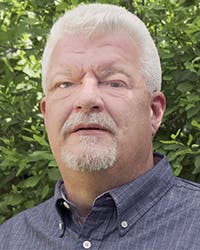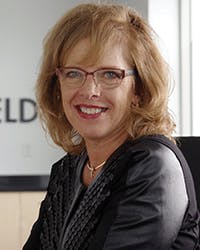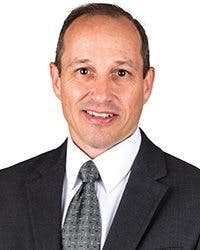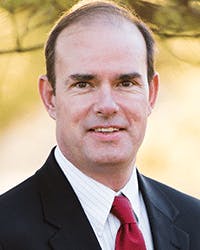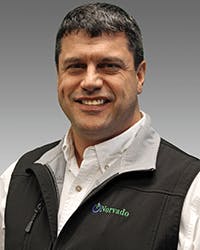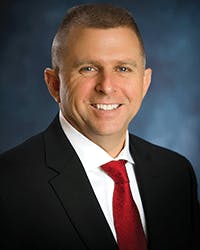For Part 2 in this series, we asked the ICT Visionaries the following questions, and requested that they answer 3 of them. Learn what our Visionaries have to say about becoming an UnTelco, small cell challenges, innovation strategies, and more.
FIBER AND 5G
5G is now poised for launch worldwide. Clearly, 5G relies on fiber being extended deeper into the access network, and closer to the customer. Providers must deploy more small cells, home spots and hot spots in higher bands, with a coverage radium measured in meters versus kilometers.
Why is that not happening faster? What is needed for fiber densification, fiber to rural areas, and fiber to meet the needs of 5G — sooner than later?
BEING AN UNTELCO
To many, telco networks are perceived as a utility, heavily regulated and with little service innovation. A recent research report by ABI Research (https://www.abiresearch.com/) shares that at some point the access-driven market will be completely commoditized; therefore, telcos must look at new sustainable business models.
Many verticals, including manufacturing, transport,healthcare, logistics, mining, retail, automotive, and government, are experimenting and implementing a complete set of new technologies while interfacing with a whole new range of vendors and system integrators. Telcos can claim a dominant role as a key technology partner and develop new revenues beyond simple connectivity; at ABI Research they call this the UnTelco concept.
How can service providers transform into UnTelcos to protect their future?
CORD
Central Office Rearchitected as a Data Center (CORD) initiatives are transforming Central Offices (COs) into hubs to host a diverse set of wireline, wireless, and cloud-based services. Why? Because COs today must be able to support both fixed and mobile communications and a ton of new subscribers.
According to experts, the next-gen CO could support about 35,000 subscribers. A typical CO today can support only about 5,000 subscribers. Clearly, that’s a huge change.
What must providers and vendors do to make COs the strategic point in providers’ networks that delivers all sorts of new experiences, including 5G use cases, IoT, and immersive media and entertainment?
SMALL CELLS
The FCC recently approved an order to ease costly federal reviews on small cell deployments. Until now, all small cell installations were required to be reviewed under both the National Environmental Policy Act (NEPA) and National Historic Preservation Act (NHPA), which previously were intended for large utility towers.
Accenture (www.accenture.com) says that NEPA and NHPA reviews account today for 29%, or $9,730, of the average costs of a small cell deployment. That accounted for $36 million in costs in 2017, and will rise to $241 million in 2018, the year when 5G small cells are expected to be deployed.
American, Chinese, and Korean companies that cooperated in developing 5G standards have become increasingly focused on being first — or best — to deploy the new wireless technology. US carriers Verizon and AT&T have both announced multi-city 5G deployments for the second half of 2018. (Please visit https://venturebeat.com/2018/02/01/after-fuzzy-announcements-att-and-verizon-now-have-clear-5g-roadmaps-for-2018/.)
How does this impact your company (either as a service provider or vendor)?
SHOW ME THE MONEY
According to the ITU (www.itu.int), only 48% of the world’s population is using the Internet. Part of the problem is that telcos are facing unfavorable ROI when they try to provide rural area coverage. Even for urban areas that have Internet services, speeds are often poor.
Thankfully, rural areas will receive some help from the government with $600 million earmarked for rural broadband as part of its $1.3 trillion omnibus spending bill recently signed into law. These funds will be delivered to service providers and other enablers of rural broadband through the USDA’s Rural Utilities Service (RUS).
In your opinion, what specific technologies and tactics should providers use to get the most bang for the buck?
INNOVATION STRATEGIES
How are you handling innovation in your organization? What are the most important things to consider when embracing an innovative mindset for any business?
Resource
The FCC order, "Accelerating Wireless Broadband Deployment by Removing Barriers to Infrastructure Investment" (WT Docket No. 17-79), will be available at the Federal Register online. (Please visit https://www.federalregister.gov/agencies/federal-communications-commission.)
FIBER AND 5G
With the increasing need for fiber deeper in networks, the familiar model of fiber counts "tapering" down as it is deployed farther out in the network is being turned on its head. Whereas a few fibers were all that was necessary to serve the most distant points of the network in the past, the low-latency response necessary to leverage the central control of technologies such as C-RAN is driving a need for much greater fiber counts.
Still, there is not a "one size fits all" solution in terms of fiber density. This drives the need for flexible solutions that assure fiber availability when and where needed, no matter the location in the network. Early adopting service providers are therefore challenged to balance loads much deeper in the outside plant network.
BEING AN UNTELCO
In the past, service providers were guaranteed revenue simply because they were able to offer the network to subscribers. Services over the network were limited and dependent on the service provider’s ability to provide them. Now that the network serves largely as a conduit that carries an ever-increasing variety of data, it is up to each provider to conceive and develop ways to monetize this asset in different ways.
We are already seeing this in practice in different ways across the industry. For example, AT&T Adworks is offering a service in which it dynamically changes information on screens deployed across the network over a variety of platforms. Given that service providers are really defining how the SDN evolves, one expects that they are in the best position to define future offerings that will take advantage of this network knowledge.
INNOVATION STRATEGIES
At Amphenol Broadband Solutions we strive to create an innovative atmosphere across the enterprise. We have done this by setting up our company in a way that focuses as much energy as possible on our customers, the service providers. Our "front line" sales team has a direct relationship with product managers and engineers. In this way, we maintain a strong focus on solving network challenges in new and creative ways.
Innovation does not end there, however, as each employee adheres to our Core Values which states, in part, Creativity and efficiency define how we work each day through product design, operational efficiencies, and forward thinking.
[toggle title=”Biography and Company Profile” load=”hide”]Mike is responsible for directing all technology efforts at Amphenol Broadband Solutions, bringing together the creative forces of Times Fiber, Holland Electronics, Extreme Broadband Engineering, and All Systems Broadband. Mike has over 25 years of telecommunication experience with an outside plant focus; the first 20 years of experience began at Raychem. Previous roles include product development, product management, and sales.
Email: [email protected]
LinkedIn: /michaelgrice
Amphenol Broadband Solutions is a provider of custom-engineered solutions and an independent manufacturer of connectivity products for service providers. Specializing in products that increase revenue and simplify operations for applications such as fiber to Multiple Dwelling Units (MDU), fiber to the business (FTTB) and fiber to the home (FTTH), ASB counts the country’s largest telcos and cable companies among its valued customers. The company’s product lines include; fiber cables and apparatus, fiber enclosures and shelves, passives, HDMI and A/V cables, and more. ASB’s passive products include a variety of splitters, CWDM, DWDM and hybrid circuit arrangements contained in the most compact form factors in the industry. More information is available on the company’s website at www.go-asb.com. www.allsystemsbroadband.com[/toggle]
FIBER AND 5G
We have aggressively expanded our fiber footprint over the past few years, both to consumers and businesses, and we continue to significantly invest in fiber across the country in 2018. In fact, we plan to reach over 12.5 million residential and 8 million business locations with fiber by mid-2019.
This scale allows us to build and manage fiber in a cost-effective and efficient way. As an integrated carrier, we use the same fiber optic network serving our wireline customers to also backhaul wireless 4G and, in the future, 5G traffic.
Fiber is a key component of our 5G deployment, including meeting our plans to be the first US carrier to launch standards-based, mobile 5G starting in a dozen markets later this year. Because of factors such as differences in population density between rural and urban areas, we’ll use a mix of techniques to deliver connectivity to our customers. This includes densification through small cell deployment, and use of various spectrum assets, such as low-band, mid-band, and high-frequency bands, including millimeter wave.
INNOVATION STRATEGIES
We approach Innovation in various ways within our organization. Establishing a trusting relationship with employees is first. Employees need to understand why you’re advocating towards change which starts with their inclusion in the process through communication. From identification of a problem, to creation of a solution, and ultimately implementation, communications must be clear, concise, and inclusive. Lastly, a clear understanding of the problem or opportunity and an agreed-upon solution.
A successful business is one with insight, ability, and willingness to identify new opportunities. Innovation is the process of making those ideas a reality. Ultimately, innovation is an evolution of a business to create efficiencies and become more effective at delivering their product to their customers.
SMALL CELLS
We applaud the FCC for recognizing the benefits that small cell networks will bring to communities across the country. Small cell equipment is streamlined, with a minimal impact on environmental, historical, and tribal resources. Moreover, small cell equipment is typically placed in rights-of-way and near other existing structures, where the public has come to expect vital infrastructure. The FCC’s recent order is expected to eliminate costly and burdensome reviews for many small cell facilities. This will allow AT&T to deploy critical infrastructure quicker and at a substantially less cost than under current regulations. Simply put, the new FCC regulations will allow AT&T to bring the benefits of small cell facilities to more consumers in communities across the country.
[toggle title=”Biography and Company Profile” load=”hide”]Natasha leads a customer-centric culture that drives change and constant improvement for Provisioning and Maintenance of the Local Network Services (LNS) Network along with Low and High Speed Service Delivery (DS0, DS1, DS3) and Maintenance. Natasha began her career with AT&T in 2009. During her career, she held positions working/leading teams in Network Operations, Customer Care, Uverse Field Operations and Service Assurance. In March, 2016 she was promoted to Director of Hosting, Cloud and DMS services. She began her current position in the Global Delivery & Assurance team in November 2017. Natasha earned an MBA degree and Bachelor of Science degree in Mechanical Engineering from the University of Missouri Kansas City.
Email: [email protected]
Social Media: www.linkedin.com/in/natashaclarkmba
Bill Walker
Senior Director, Network Architecture – SDN, NFV, and Cloud
CenturyLink
BEING AN UNTELCO
There are really 2 business models in play here. Cost optimization is a key pressure when delivering a utility-based, lower margin service, but we can’t allow that mindset to drive our strategy. Becoming an UnTelco means running a second business strategy, more in line with the big Internet success stories and companies that leveraged "behavior transformation" of their customers. Think Henry Ford, Jeff Bezos, and Steve Jobs. They leveraged technology to change how people work and play.
So number 1, strive to become the best telco possible, in the most efficient ways possible. Then, leveraging the benefits of "owning the network" (latency, bandwidth, locality, etc.), deliver more innovative services, partnered services, and enhanced services, in a dynamic and market-aware start-up mindset.
CORD
First, we need to undo 50 years of behavior and operations that make them "COs". While protecting the integrity of the communications networks (so that emergency services will still save lives), and the safety of the working environments (the basis of NEBS), we need to view them as "service points". Some IT and network services fit COs very well, others fit in Metro and Exchange locations. CORD, Edge Cloud, NFV, and other buzzword technologies, make this possible, but we need to re-engineer services around, or in cooperation with, the network, rather than just building more fat pipes to connect consumers of data to the producers of data in giant. Digging ditches and laying new fiber to keep up with the growth in traffic makes "pipe spread" an unsustainable model.
SHOW ME THE MONEY
New wireless technologies in fixed and mobility configurations will help to cover wider small town footprints and fill in some of the gaps in towns where construction isn’t feasible, and the legacy plant can’t support acceptable speeds. Millimeter wave, higher bandwidth PON, 5G technologies, mesh networks, and many other technologies, can contribute to new network architectures. The speed of change in technologies means that we constantly need to re-evaluate our plans and the possibilities, and not expect to build networks in static configurations that will last 30 years and work everywhere. Agile and adaptable network development is my prediction for future success.
[toggle title=”Biography and Company Profile” load=”hide”]Bill’s technical expertise is in capacity management; service level management; and systems, network, and infrastructure architecture. He also has a strong background in Solaris- and Unix-based systems, as well as cloud systems architecture, virtualization and server systems architecture. He has extensive experience in multiple industries, including telecom, energy, retail, banking and finance, government and public sector and healthcare. Prior to CenturyLink, Bill was with Huawei, based in Shenzhen, China. At Huawei, he led the IoT, Smart City and Carrier IT initiatives, and was an early supporter of SDN and NFV efforts.
FIBER AND 5G
I’ve hung a large wall-hanging in my office that reads Life is unchartered territory. It reveals its story one moment at a time. As an impatient person, it seems like I’m always in a hurry. This quote from Leo Buscaglia reminds me that sometimes the journey is long for a reason. The same is true for 5G. The endgame sounds fabulous, but there have been many twists and there will be more turns as our industry rolls out services.
The initial 5G focus is on Fixed Wireless Broadband. Dense urban areas will experience the 5G investment first. Yet, even with hundreds of thousands of 5G nodes they might only reach less than 5% of US homes. Future 5G applications like drones, connected cars, and automated traffic control, are likely to place 5G antennas near busy roadways. One thing for sure: all this fiber will require good planning. Fiber management is often easy to overlook before it gets out of hand. That’s why Clearfield focuses on fixing these fiber management situations before they get started by using Clearview Cassettes and pushable fiber as the common building blocks of sound modular fiber design.
SMALL CELLS
When it comes to fiber deployment, any effort to reduce construction costs will naturally enable more fiber projects to be rolled out quicker and provide operators a shorter time to revenue. Clearfield echoes this approach by continuing to focus on a Labor-Lite method of fiber deployments making the path between connections easy-to-install, providing fiber protection, and facilitating scalable and repeatable processes. FieldShield fiber management pathway products provide a series of small-profile ducts addressing a variety of network environments that create pathways for easy and pushable deliveries of 1 to 24 factory terminated and tested fibers. This is more than plug-and-play, this is a Labor-Lite approach — allowing more rapid subscriber turn-up.
SHOW ME THE MONEY
During a Clearfield WISP Summit, executives representing wireless Internet service providers from all over the country revealed nearly 90% have started to deploy or are considering deploying fiber-to-anywhere (FTTx) in their markets. While initial deployment costs are higher for FTTx than for fixed wireless, the higher data rates and much longer equipment lifespans make fiber the most bang-for-the-buck technology on the market.
To paraphrase Buscaglia: Build for today — but choose optical fiber to future-proof the reveal of what’s yet to come.
[toggle title=”Biography and Company Profile” load=”hide”]A founding member of Clearfield, Inc., Cheri is considered a communications visionary. She was appointed Clearfield President and CEO in 2007 after having served as President of APA Enterprises’ subsidiary APA Cables & Networks. Under her direction, Clearfield has recorded 10 consecutive years of profitability and posted historic gains in both the market capitalization and shareholder equity. Under her leadership, Clearfield was named to the prestigious Forbes Annual List of America’s Best Small Companies in both 2013 and 2014.
FIBER AND 5G
While the promise of 5G captivates the communications industry and sets high expectations for performance and availability, a bit of patience may be required before we see truly blazing-fast speeds and cool new applications. In the meantime, carriers are optimizing their current assets and spectrum by deploying optical fiber deeper, densifying wireless nodes, and improving the 4G network. The first phase of densification is taking place in congested and highly populated areas, then it will expand to areas targeted for future 5G upgrade. Planning for early 5G adoption includes identifying viable business models, conducting trials, outlining best practices, and setting budgets for scaled deployment. Carriers are even exploring novel cell-site locations to achieve the higher density that 5G requires. Imagine cell sites on street lamps, signage, and other possibilities managed by a myriad of entities. These kinds of deployment complexities could result in delays, but the surging demand for higher speeds and low-latency applications will outweigh the challenges. In short: 5G will be disruptive, but its benefits will be transformative.
INNOVATION STRATEGIES
Today’s communications innovations are no longer limited to isolated systems, since the boundaries between applications are disappearing. For instance, wireless and optical networks are merging into one ubiquitous access fabric. Furthering the transformation are the promise of 5G and potential new business models driven by AI, AR/VR, and IoT — all setting the stage for a redefinition of what it means to be innovative. Moving forward, success will increasingly depend on orchestrated co-innovation between adjacent and even nonadjacent elements of the communications ecosystem. Not just on the horizon but on our doorstep is a new reality — one in which a robust road map factors in even the connection between software and the passive plant.
CORD
Central Office Rearchitected as a Data Center (CORD) brings data center functionality to the CO through a combination of old and new: a traditional CO augmented with data center equipment like Ethernet switches and servers. CORD’s performance and efficiency improvements are gained by leveraging single-mode fiber on the transport side, where distance is critical, and multimode connections inside for processing over servers and Ethernet switches. As more Ethernet technology enters the CO, the number of connections grows.
[toggle title=”Biography and Company Profile” load=”hide”]Bob is responsible for global Carrier Networks Market Development to include strategy and execution of Corning’s Fiber-to-the-Home (FTTH), Fiber Deep, Inside Plant, and other Carrier network applications. Active for 15 years promoting optical fiber networks through education and public policy, Bob has developed commercial and technical expertise in all aspects of optical communications. He is one of the three founding individuals of the FTTH Council NA. Previously, Bob was Director for Global FTTH Program Management, and has held a variety of Engineering, Marketing ,and Market Development positions. Prior to joining Corning in 1997, Bob served as a Nuclear Power Engineering Officer in the US Navy.
INNOVATION STRATEGIES
All ESPi product innovations come from customer challenges. I always start with the challenge and work backwards, pretending I could solve it. If I could build anything in the world to solve this challenge, what would it look like? My favorite question to our engineers: Is this impossible to solve or just difficult? If we could solve this problem, how big is the market for this? The final step is to develop a prototype to show potential customers. Our customers aren’t shy and will tell you exactly what you did right and wrong with the product. Go back to the lab, innovate, and take it back out to customers. Keep this cycle up until you get the "WOW!" factor from the customers. Once you get the "WOW!" factor, we know it’s a viable product.
SHOW ME THE MONEY
I was recently approached by Ryan Andring of Arvig communications in Minnesota. His challenge was a need to power a fiber-fed 12-port VDSL unit from Calix using only solar. It’s easy to use solar in Texas but can we make it reliably work in Minnesota? I accepted the challenge and innovated a new product called Voltar-Plus. Ryan told me that setting a utility meter was going to be costly and require a significant amount of time. If you must set a meter to power that sealed cabinet, the provider would have a cost of $25 to $40 per month just for electricity. At that rate, you must have 1 subscriber just to pay the electric bill every month. This was unacceptable, and I knew we could do better. We successfully turned up a Calix E3-12 powered only by the sun. The challenge of the grid is that it never gives you a warning that it is going down. With the alarm capability within the Voltar-Plus unit, they now get a notification several hours before the unit goes down. Now imagine 2 of these plugged into the A and B power input. Is this more reliable than the grid? To be precise, it’s twice as reliable with zero monthly electricity cost. To top it off, you can install the entire system in a single day.
BEING AN UNTELCO
Security systems and remote cameras are becoming more important now than ever before. The amount of data they can create is substantial. The UnTelco is primed for this opportunity with the techs to install it, the data center to store it, and the support personnel to take care of the customer.
[toggle title=”Biography and Company Profile” load=”hide”]Chris has more than 20 years of telecom engineering experience, and has a passion for powering things. He was instrumental with one of the very first IPTV-over-copper deployments in the US. He was also the 1st MEF CECP engineer in Oklahoma. He holds multiple patents and continues to create innovative ways to power network devices, including the award-winning Voltar solar UPS. He lives in Stillwater, Oklahoma, with his wife Paige and 2 Westies. Email: [email protected]
SMALL CELLS
As 5G pays the way for small cell deployments with government regulation, this helps Tier II providers as we migrate to deploying wireless. This allows Tier II to look at how wireless can help in customer drops and commercial applications. Often we find crushed conduit or an expensive 500 ft to lay fiber. If we adapt small cell practices, we could find ways to reduce these costs or find alternative faster deployment models.
SHOW ME THE MONEY
Wireless has been a major theme in recent years with government funding to provide service to the rural parts of America. As we hit the rural areas of the country, the cost of providing a physical medium to each home exceeds what the government is willing to supplement. This is the last 10% is 90% of the time, money, effort concept. As we push further to the last 10%, we need to look at other methods that take less physical installation and cover larger areas with the speed requirements needed. Wireless is an obvious technology that fits this concept. Many companies are looking at unlicensed space. The government is trialing out 3.5 Ghz or CBRS, and this will be an interesting look at the future of "lightly licensed" or alternative licensing models.
INNOVATION STRATEGIES
Innovation is what drives company success and what every company desires. Innovation does go hand in hand with failure and risk. One of the most important things I try to instill in my organization is that failure is not bad. In failure, my organization has made even stronger standards and better designs. The second thing I try to instill is no idea is a bad idea. Sometimes we do not give our team time to develop their ideas due to tight timelines. We already have an assumption of how the project will end, and we try to speed up the solution. I find giving my team the vision but not the high-level solution allows them to develop their own ideas — and they often surprise me with an innovative design.
[toggle title=”Biography and Company Profile” load=”hide”]Christopher creates network standards for ISP and OSP Engineering. He is currently based out of Allen, Texas. Previously, Christopher worked as Director of Video and Network Engineering. He graduated from Tulane University with a Bachelors of Science in Electrical Engineering.
BEING AN UNTELCO
The access market has remained viable for many years despite being predicted to be unsustainable without augmenting additional services and revenues to support it. I would contend that most rural independent telcos have become UnTelcos already by delivering an access connection that began as a simple copper telephone line just over 20 years ago to a fiber-all-IP connection delivering feature-rich IP services. What is next on the list? Helping satisfy the growing connectivity needs for anchor institutions with redundant, always-on connections while continuing to satisfy their need for high-speed access to data in the cloud. Give people the connections to satisfy their growing needs of social interaction and entertainment delivery. Help both businesses and residential with their technical networking needs to ensure they are having an excellent experience with our access connection, with an emphasis on security and great wireless connectivity and coverage.
CORD
CORD is a simplification of the network for service providers, a ratcheting down of the equipment that is required in the network. As a rural network provider with 19 CO locations, our focus will be to utilize the data center design concept to concentrate the more various routing and access equipment platforms down to fewer locations to drive down capital and operating expenses. The expensive optical, routing, and access platforms required at every CO are what drive up power and cooling costs as well. This will be a multistep process that will involve physical plant additions to provide geo-diverse fiber routing to wire center buildings that will be required to eliminate electronics.
SHOW ME THE MONEY
To make the dollar stretch and to achieve today’s 30MB download speeds to the many rural areas that are underserved or not served today, the best way to accomplish that is by utilizing the newest technology over existing infrastructure first. Buildout fiber connectivity to get copper loops at or under 5K feet. When the plow goes into the ground it should be engineered to accomplish fiber to the premises and not just fiber to the node. At Norvado, we started that process many years ago and are now 90% fiber-to-the-home with the remaining copper customers on these shorter loop digital serving areas.
[toggle title=”Biography and Company Profile” load=”hide”]Rob is the Broadband Operations Manager at Norvado, located in Northwestern Wisconsin, where he has worked since 1998. He spent 7 years prior to that with Nortel in the transport, switching and cellular markets earning him 27 years in the telecommunications industry with extensive experience in network engineering and designing of wireline, wireless, cellular, IPTV and broadband networks. He can be reached at [email protected].
BEING AN UNTELCO
As a service provider, innovation includes providing faster and faster connectivity solutions. At some point, however, the pipe is no longer what the customer is purchasing, because it’s simply a commodity — and precisely where the transformation must take place. This will require telcos to successfully manage a customer’s Wi-Fi experience within their home while adding new offerings. Together, these 2 pieces will lead to continued revenue streams for service providers and opportunity for the customer to leverage the underlying broadband pipe. Online protection services and in-home professional services are just 2 examples that will help ensure the customer experience is acceptable — and will become increasingly important for broadband service providers. Other ways telcos can consider to better position themselves for the future is diversification. TDS Telecom, for instance, has expanded into cable, hosted, and managed services, and is branching out by partnering with municipalities to construct fiber optic networks.
SHOW ME THE MONEY
Broadband services continue to be a critical communications enabler, regardless of where customers live. At the same time, the economics of providing acceptable broadband speeds in rural areas can be extremely challenging. With government funding assistance, the economics make build-out and expansion efforts to deliver fast and reliable Internet service possible. While backbone infrastructure will be best-served on fiber technology, the Last Mile will continue to include multiple technologies, such as fiber, copper, coax, and wireless. While there is no clear winner, service providers will continue partnering with vendors to create and deliver more cost-effective Last Mile connectivity solutions. This is critical in order to ensure rural communities have access to adequate Internet services — at a reasonable price.
INNOVATION STRATEGIES
Embracing an innovative mindset comes in many forms. It includes developing strategies that provide innovative products and services as well as the internal talent responsible for developing, supporting, and selling, those products and services. As a technology organization, we must commit to the growth strategies that ensure our products and services remain relevant (and important) to our customers. We must also invest in our people infrastructure, in the ways our employees want, such as philanthropic and volunteer engagements. Simultaneously, we must ensure the work environment and culture is inclusive, diverse, and open to challenges to the status quo.
[toggle title=”Biography and Company Profile” load=”hide”]Andrew joined TDS Telecom in 1989. Today, he has responsibility for the entire Field Services team. Under his leadership, this team provides timely service installations for consumer and commercial customers. This team also conducts routine preventative maintenance, including testing the integrity of the inside and outside plant networks to ensure ongoing availability of Internet, video and voice services. This team is also responsible for repairing outages caused by natural disaster, equipment failure, or damaged network facilities.
Vice President Network Engineering
Verizon Wireless
5G
Verizon will be first to market in the US with 5G residential broadband and 5G mobile services. Starting in 2015, with the creation of the 5G Technology Forum, our work with our partners to accelerate a global 5G standard paid off when the 3GPP announced (part 1 of) 5G NR in December 2017. Our 2017 first-mover advantage in testing 5G over millimeter wave spectrum with real customers met and exceeded our expectations for speed, latency, distance, and propagation. We remain on track to deliver on our 5G residential broadband deployment plans, and are aggressively focused on 5G NR mobility testing and deployment plans. Verizon is uniquely positioned to bring together multiple technology, device, and infrastructure partners to make 5G a reality.
INNOVATION STRATEGIES
We believe in the possibilities of science, pushing the boundaries, taking calculated risks, and making investments, which are fundamental to progress and broad-based change, and the introduction and adoption of the next generation of technology. This approach, in addition to a focus on the customer and a steadfast commitment to deploying the best, most reliable networks, has helped our company build our world-class Fios network, 2G and 3G wireless technology, as well as the industry-leading 4G LTE wireless network, including the latest advancements with LTE Advanced features — and now we’re on to 5G. In each of these technological leaps, the collaboration with our ecosystem partners, along with our talented and dedicated engineers, has been an important key to our success, and will be especially important as we embark on 5G networks.
FIBER AND 5G
Fiber will continue to be essential for wireless and wireline technology. The fiber architecture we’ve deployed and are building is multi-use for 4G, small cell densification, pre-positioning for 5G, and incremental wireline opportunities. We see further enhancements to our fiber footprint across the country as a significant asset that will enhance our ability to compete and provide great customer experiences. Our recent XO acquisition provides fiber presence in 45 of top 50 US markets. We are working closely with Corning, who will deliver over 12.5 million fiber miles a year for the next 3 years. We also announced a fiber commitment contract with Prysmian for about $300 million. This fiber-enabled multi-purpose network will enable efficiencies and faster provisioning of new services.
[toggle title=”Biography and Company Profile” load=”hide”]Andrea is responsible for the planning, engineering, building and performance of Verizon’s voice and data networks, including its growing 4G LTE Advanced network and emerging 5G Network. Prior to her current role, Caldini was VP of Engineering and Network Assurance for Verizon’s southern markets. She also served as a Director in planning for SDNs, NFV, and orchestration for Verizon’s Global transformation to virtualization. Her international work, which includes 5 years in Switzerland, involved coordination with European wireless carriers as well as consulting on technology solutions in Germany, Switzerland, Poland, Czech Republic, Slovakia, Austria, and the Baltics. She has a bachelor’s degree in Telecommunications from the University of Tampa and an MS from Stevens Institute of Technology.
FIBER AND 5G
Fiber deployments remain demand-driven, primarily tied to backbone capacity/diversity, enterprise and wholesale services, tower demands, and consumer services. While 5G promises to dramatically reshape tower demands, it remains the equivalent of potential energy when it comes to fiber densification. That potential won’t become a kinetic catalyst for new fiber deployments until wireless companies start identifying locations, capacities, and service expectations.
SHOW ME THE MONEY
Rural markets require flexibility, as a one-size-fits-all mentality soon fails to fit anything. This means diverse equipment and configuration options for backhaul and distribution, as well as a flexible set of tools for assessing and optimizing deployment strategies for widely varied environments. While a diverse toolkit exists for broadband delivery, many recent advancements like G.fast and VDSL2 vectoring still provide benefits that diminish rapidly over distance.
However, fixed wireless is quickly developing into a much more interesting solution for delivering rural broadband. Windstream is currently expanding our use of fixed wireless technology for both backhaul and distribution solutions for rural consumer broadband.
INNOVATION STRATEGIES
Innovation is an exciting topic, and we continue to innovate in many areas. We recently enabled an SDN orchestration solution supporting Windstream’s SDNow optical wave service. We’ve constructed tools to automate targeted alarm, ticketing and repair activities, enabling automated responses where appropriate, and better focusing our staff on issues that benefit from human insight. We’re also innovating on smaller scale opportunities, such as redesigning the tools used to internally collaborate and share critical project information.
A few personal thoughts about innovative culture:
Innovation must be consistently encouraged and visibly prioritized. Otherwise, thoughts gravitate to business as usual, complacency takes root, and creative individuals often move on to more flexible organizations.
Innovative ideas yield no results without execution, and execution is often best delivered in bite-sized chunks. Key benefits are accelerated, and it’s easier to course-correct a smaller project.
Execution is inherently risky, and occasional failures should be expected. The key to innovation isn’t being error-free — it’s quickly recognizing mistakes, learning from them, and making rapid and effective course corrections. Even the Apollo 11 mission had 5 scheduled course corrections (though not all were used), and that was an environment with near-zero tolerance for failure.
[toggle title=”Biography and Company Profile” load=”hide”]Jeff is responsible for the standards and integrity of the Windstream transport network. His organization is responsible for establishing the engineering equipment standards and roadmap, the provisioning of layer 1 and 2 infrastructure, and ensuring the continuing reliability and integrity of the Windstream transport network. Jeff has over 20 years of telecommunications experience, both ILEC and CLEC, predominantly focused on architecture, test and certification, planning and engineering. Jeff can be contacted via email at [email protected].








